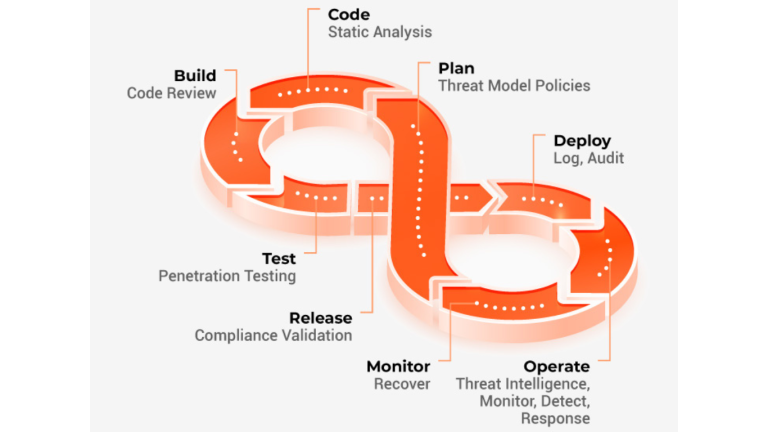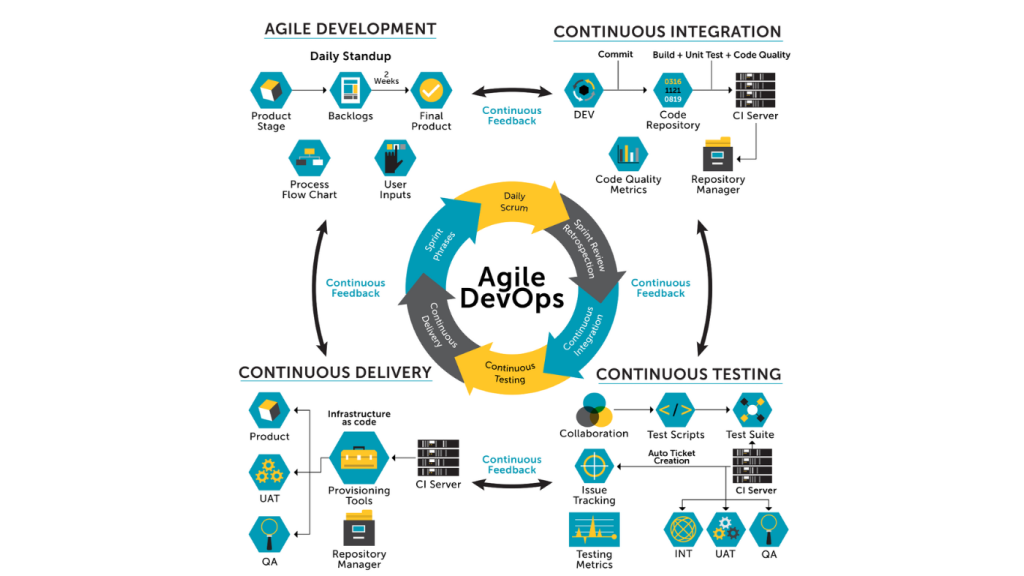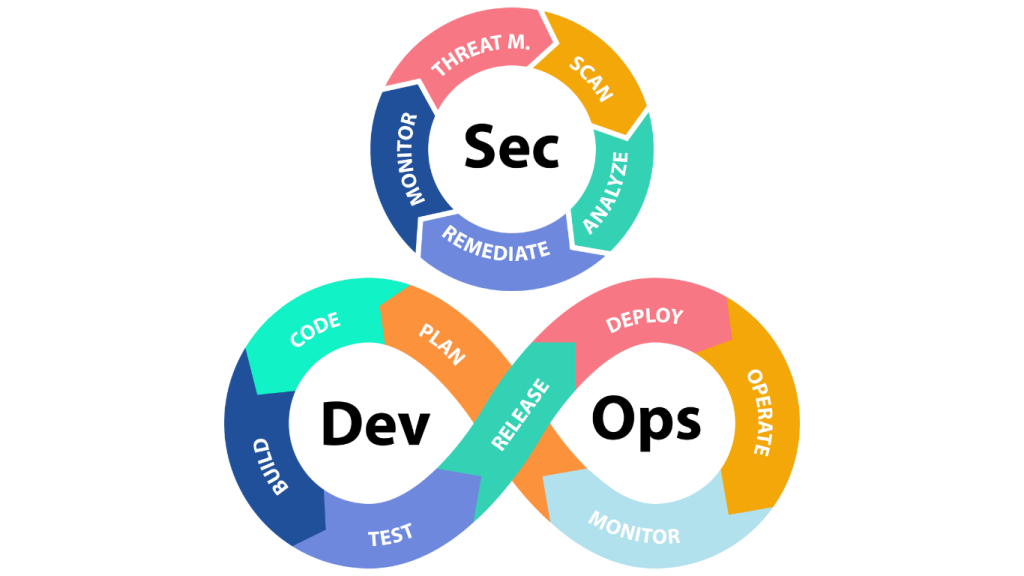Introduction:
Agile and Scrum methodologies have revolutionized how software is built faster releases, closer collaboration, and iterative improvements. But this speed often comes at the cost of security. Security is sometimes left as a final checkpoint instead of being a part of the continuous development process. This is where DevSecOps in Agile becomes critical.
DevSecOps introduces security practices into every phase of the software development lifecycle (SDLC). When implemented correctly within Agile and Scrum frameworks, it ensures that security is not an afterthought, it’s an integral part of your process.
In this blog, we’ll explore how to integrate DevSecOps into Agile teams, why it’s essential, how it works in practice, and how DevSecOps training and certifications such as the AWS DevSecOps Certification can support this journey.
What Is DevSecOps?
Definition
DevSecOps stands for Development, Security, and Operations. It’s a practice that embeds security throughout the DevOps pipeline from design to deployment.
Goal
The goal is to shift security left, meaning security concerns are addressed early in the development cycle, not at the end. This allows teams to detect vulnerabilities faster, reduce cost and time for fixes, and deliver more secure applications.
Understanding Agile & Scrum in Software Development
Before discussing DevSecOps in Agile, it’s essential to understand what Agile and Scrum bring to the table.
Agile
Agile is a mindset and a framework that promotes adaptive planning, evolutionary development, early delivery, and continuous improvement. It breaks work into small, manageable units delivered in iterations or sprints.
Scrum
Scrum is one of the most popular Agile frameworks. It organizes work in time-boxed sprints, usually 2–4 weeks long, with defined roles (Scrum Master, Product Owner, Development Team) and events (Sprint Planning, Daily Stand-up, Sprint Review, Retrospective).
While Agile and Scrum promote speed and collaboration, they can unintentionally sideline security without a deliberate integration strategy. That’s where DevSecOps in Agile plays a crucial role.
Why DevSecOps in Agile Matters
1. Speed Without Compromise
Agile teams release code rapidly. Without integrated security, this fast-paced cycle can lead to vulnerabilities slipping into production. DevSecOps in Agile ensures that security scans and policies evolve alongside code updates, not afterward.
2. Cost-Efficient Fixes
Fixing a security flaw in production can cost up to 100x more than catching it during development. Embedding security early through DevSecOps in Agile reduces these costs.
3. Improved Compliance
Many industries require compliance with strict standards (like GDPR, HIPAA, PCI DSS). Agile development with integrated DevSecOps helps ensure continuous compliance throughout development and deployment.
4. Reduced Bottlenecks
Traditionally, security reviews delayed releases. With DevSecOps in Agile, automated tools reduce the manual load, enabling security checks in real-time without blocking sprint progress.
Key Principles of DevSecOps in Agile
1. Security as Code
Just like infrastructure is managed through code (Infrastructure as Code), Security as Code enables teams to automate security policies, rules, and controls.
2. Continuous Security Testing
Security tools must be part of the CI/CD pipeline. Integrating tools like SAST, DAST, and container scanners in every sprint ensures vulnerabilities are detected early.
3. Developer-Centric Security
Security is everyone’s responsibility. Developers must be trained to write secure code and use automated security tools effectively. DevSecOps training equips them with these necessary skills.
4. Automation Everywhere
Automation removes the friction between development and security. Security gates, alerts, approvals, and monitoring should be automated using scripts, APIs, and DevOps tools.
Real-World Examples of DevSecOps in Agile
Case Study 1: Financial Services Company
A financial services company adopted DevSecOps in Agile by integrating container scanning and static code analysis into every sprint. They reduced their security incident rate by 60% in just 6 months.
Case Study 2: Healthcare Tech Platform
A healthcare platform implemented threat modeling during sprint planning and automated security checks in CI/CD pipelines. The result: regulatory compliance improved, and release cycles shortened.
Integrating DevSecOps into Agile Workflows
Step 1: Involve Security Early
Include security experts during sprint planning. Let them help define security stories, acceptance criteria, and threat models alongside user stories.
Step 2: Define Secure Development Backlog Items
Convert security requirements into backlog items. These should be visible, trackable, and prioritized like any other user story.
Step 3: Automate Testing in the CI/CD Pipeline
Use tools like:
- SAST (Static Application Security Testing): Scans source code for vulnerabilities.
- DAST (Dynamic Application Security Testing): Simulates attacks on running applications.
- Container Scanners: Ensures images used are secure and free from known vulnerabilities.
Step 4: Perform Threat Modeling in Sprints
At the beginning of each sprint, perform a quick threat modeling session to identify and mitigate potential risks.
Step 5: Measure & Monitor
Track security metrics such as:
- Number of vulnerabilities detected
- Time to remediation
- Percentage of code scanned
This helps Agile teams improve with each sprint, a key tenet of DevSecOps in Agile.
DevSecOps Tools That Fit Agile & Scrum
Code Scanning Tools
- SonarQube
- Checkmarx
- Fortify
Container & Image Scanning
- Aqua Security
- Trivy
- Clair
Compliance & Policy-as-Code
- Open Policy Agent (OPA)
- Chef InSpec
Secret Management
- HashiCorp Vault
- AWS Secrets Manager
These tools allow Agile teams to integrate security directly into their workflows, supporting DevSecOps in Agile environments.
The Role of DevSecOps Training in Agile Teams
Training is essential to bridge the knowledge gap between security and development. A solid DevSecOps Course helps team members:
- Understand secure coding principles
- Learn how to use automated security tools
- Integrate security into CI/CD pipelines
- Embrace collaboration with security stakeholders
Many organizations opt for recognized credentials like the AWS DevSecOps Certification, which validates cloud-native security practices.
Benefits of DevSecOps Training for Agile Teams
1. Accelerated Learning
Teams don’t just learn concepts—they learn hands-on implementations applicable to Agile environments.
2. Standardized Security Knowledge
Security knowledge becomes consistent across developers, testers, product owners, and operations.
3. Better Communication
Training fosters shared understanding between development and security, making Agile ceremonies (like sprint planning and retrospectives) more productive.
How AWS DevSecOps Certification Supports Agile Security
The AWS DevSecOps Certification is particularly beneficial for Agile teams operating in cloud environments. It covers:
- Implementing security in AWS cloud-native tools
- Automating compliance
- Securing CI/CD pipelines on AWS
By aligning with Agile frameworks, it empowers teams to apply DevSecOps practices in sprints efficiently.
Common Challenges When Applying DevSecOps in Agile
Resistance to Change
Agile teams used to speed may see security as a blocker. To overcome this:
- Highlight how security empowers speed, not slows it.
- Show quick wins from automated tools.
Tool Fatigue
Too many security tools can overwhelm developers. Solution:
- Select tools that integrate well with Agile workflows.
- Train teams through a practical DevSecOps Course.
Inadequate Metrics
Without metrics, it’s hard to improve. Implement KPIs like:
- Vulnerability fix rate
- Security test coverage
- Mean time to detect/respond
Future of DevSecOps in Agile Teams
As threats evolve, DevSecOps in Agile will become not just a best practice—but a necessity. AI and ML-driven security tools, zero trust architecture, and policy-as-code are reshaping how security functions in Agile workflows.
Organizations that embed security into every sprint, backed by robust DevSecOps training and certifications, will lead the industry in both innovation and trust.
Visualizing DevSecOps in Agile Workflows
Here is a simplified workflow diagram for DevSecOps in Agile teams:
Sprint Planning –> Threat Modeling –> Code Development –> Automated Security Testing –> Code Review –> Deployment
↑ ↓
Feedback Loop <———————————— Monitoring & Incident Response
Each phase includes security checkpoints that are automated and integrated, maintaining Agile speed without sacrificing safety.
Key Takeaways
- DevSecOps in Agile ensures security is part of every sprint, not an afterthought.
- DevSecOps training equips teams with tools and knowledge to secure pipelines.
- AWS DevSecOps Certification validates cloud-native DevSecOps practices.
- Real-time, automated testing is essential for Agile velocity and security.
- Threat modeling, security backlog items, and sprint reviews are ideal points for integration.
Conclusion:
Don’t let security be the bottleneck make it a catalyst for faster, safer software. Integrate DevSecOps in Agile today and ensure every sprint delivers both value and security.
Start your journey toward building secure, agile pipelines and empower your team with DevSecOps now.

























